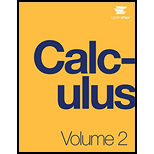
True or False? In the following exercises, justify your answer with a proof or a counterexample.
253. If the radius of convergence for a power series
To check: The given statement whether it is true or false and also justified it.
Answer to Problem 253RE
The statement is true.
Explanation of Solution
Given information:
The given statement is:
The radius of convergence for a power series
Concept used:
The radius of convergence R for a power series
Calculation:
The radius of convergence for a power series
Now, the radius of convergence for the series
Therefore, the radius of convergence for the series
Conclusion:
Hence, the given statement is true.
Want to see more full solutions like this?
Chapter 6 Solutions
Calculus Volume 2
Additional Math Textbook Solutions
University Calculus: Early Transcendentals (4th Edition)
Calculus: Early Transcendentals (2nd Edition)
Thinking Mathematically (6th Edition)
Using and Understanding Mathematics: A Quantitative Reasoning Approach (6th Edition)
A Problem Solving Approach To Mathematics For Elementary School Teachers (13th Edition)
- JOB UPDATE EMERSON GRAD ENGINEER (FRESHERS) SOFTWARE ENGG NEW RELIC BROWSERSTACK (FRESHERS) SOFTWARE ENGG FULL STACK DATA ENGINEER GENPACT + PYTHON CARS24 WORK FROM HOME #vinkjobs TELE PERFORMANCE Vinkjobs.com CUSTOMER SUPPORT Search "Vinkjobs.com" on Googlearrow_forwardB\ Prove that if T is a spanning tree of G which contains e, then Te Is a spanning tree of G * e.arrow_forward9 Q/ Let G be agraph with n vertices, then G has at least two vertices which are not cut vertices.arrow_forward
- do question 2 pleasearrow_forwardFind the first four nonzero terms in a power series expansion about x=0 for a general solution to the given differential equation w''-14x^2w'+w=0arrow_forwardLet X represent the full height of a certain species of tree. Assume that X has a normal probability distribution with mean 203.8 ft and standard deviation 43.8 ft. You intend to measure a random sample of n = 211trees. The bell curve below represents the distribution of these sample means. The scale on the horizontal axis (each tick mark) is one standard error of the sampling distribution. Complete the indicated boxes, correct to two decimal places. Image attached. I filled in the yellow boxes and am not sure why they are wrong. There are 3 yellow boxes filled in with values 206.82; 209.84; 212.86.arrow_forward
- Answer this questionarrow_forwardIn this exercise, we will investigate a technique to prove that a language is notregular. This tool is called the pumping lemma.The pumping lemma says that if M = (S, I, f, s0, F ) is a DFA with p states (i.e., p = |S|) and if the wordw is in L(M ) (the language generated by M ) and w has length greater than or equal to p, then w may bedivided into three pieces, w = xyz, satisfying the following conditions:1. For each i ∈ N, xy^i z ∈ L(M ).2. |y| > 0 (i.e., y contains at least one character).3. |xy| ≤ p (i.e., the string xy has at most p characters). Use the pumping lemma to show the following language is not regular (HINT: Use proof by contradictionto assume the language is regular and apply the pumping lemma to the language):L = {0^k1^k | k ∈ N}arrow_forwardA prefix of length ℓ of some word w are the first ℓ characters (in order) of w.1. Construct a context-free grammar for the language: L = {w ∈ {a, b}∗ | every prefix of w has at least as many a’s as b’s}2. Explain why every word generated by your context-free grammar (in Part 1) is contained in L. Then,prove via induction that every w ∈ L is produced by your context-free grammar.arrow_forward
- Consider a simplified version of American football where on any possession ateam can earn 0, 3 or 7 points. What is the smallest number n0 of points such that for all n ≥ n0 and n ∈ Na team could earn n points. You must prove that your answer is correct via induction (HINT: Don’t forgetto show that n0 is the smallest number above which any number of points is reachable).arrow_forwardConsider a vocabulary consisting of the nucleotide bases V = {A, T, G, C}.Construct a DFA to recognize strings which end in AAGT .(a) Draw the DFA with clear markings of all states including start and acceptance state(s).(b) Simulate the DFA to show that string T GAAGT will be accepted by the DFA.(c) Simulate the DFA to show that string T AAGT G will not be accepted by the DFA.arrow_forwardA palindrome is a string that reads the same backward as it does forward. For example, abaaaba is a palindrome. Suppose that we need to define a language that generates palindromes.(a) Define a phase structure grammar that generates the set of all palindromes over the alphabet {a, b}clearly describing the recursive rules that generates palindromes. Use the notation Symbol → rule. Theempty set is denoted by λ. Clearly identify the terminal and non-terminal symbols in your grammar.(b) Show that the palindrome abaaaba can be recognized by your grammar. To show this, show all stepsof parsing the expression abaaaba using the rules you defined above.arrow_forward
